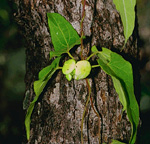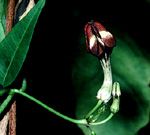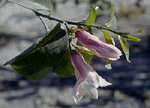 |
This large, pantropical family is most diverse in the Americas and Africa. Asclepiads are found almost throughout Australia, excepting the south-west of Western Australia and Tasmania. Most species, however, are restricted to the tropical north and east, often in rain forests.
Characteristic features of the family Asclepiadaceae in Australia include: - herbs or shrubs, often climbers, rarely trees, usually with milky sap that exudes freely from broken stems and petioles
- leaves and flowers often rather thick, semi-succulent; leaves opposite, often with a patch of small glands (colleters) near the base of the lamina
- flowers 5-partite, actinomorphic, in cymes or umbels, often with some type of corona (crown of processes) developed from the corolla
- stamens variously united with the style to form a specialised 'gynostegium'
- ovary of two carpels free at the base but fused by their stigmas, developing into a pair of follicles (sometimes only one developing)
Description
Evergreen, deciduous or semi-deciduous shrubs, woody or herbaceous vines climbing by twining stems, or biennial or perennial terrestrial herbs (rarely aquatic herbs rooted in the substrate with their leaves emergent), perennating by bulbs, tubers, rhizomes or taproots. Vegetative reproduction absent or by rhizomes or stolons. Stems succulent, unarmed, nodes conspicuously swollen or not conspicuously swollen, internodes solid or hollow. Extra-floral nectaries (small, finger-like glands) often present at the base of the leaf lamina. Internal secretions of milky sap (latex) or of coloured sap. Plants glabrous or with simple, non-glandular, unicellular, uniseriate or multiseriate hairs. Leaves well developed or much reduced (i.e. to scales, etc.), opposite, cauline if herbs, petiolate, subsessile or sessile. Stipules absent. Lamina simple, symmetric or asymmetric, filiform, acicular, subulate, linear, lanceolate, ovate, elliptic, oblanceolate, ovate, oblong or orbicular; base cuneate, attenuate, rounded, cordate, hastate or sagittate, lobed or auriculate or oblique; margins entire, ±flat, revolute or recurved; one-veined, or the venation pinnate, or palmate, with the midrib conspicuous, and the tertiary venation reticulate or not; surfaces not punctate; herbaceous, leathery or succulent. Plants with all the flowers bisexual. Inflorescences axillaryor terminal, consisting of racemes, cymes or umbels. Bracts present. Mucilaginous hairs present on buds. Pollination by insects or birds. Flowers odourless, fragrant or malodorous; stalked. Floral disc absent; nectaries present on the perianth or anthers. Perianth regular, of 2 dissimilar whorls, imbricate or valvate in bud. Calyx segments fused, with 5 lobes; calyx bell-shaped, herbaceous. Corolla segments apparently free or fused, with 5 petals or lobes, alternating with the calyx lobes; corolla wheel-shaped, bell-shaped, urn-shaped, funnel-shaped or salver-shaped, white, cream, yellow, orange, red, magenta, purple, violet, green, grey, brown or black, without contrasting markings, or streaked, spotted, etc, membranous or succulent; lobes ±entire or ciliate or fimbriate, separately or together with the stamens forming various coronal structures. Fertile stamens 5, opposite to the calyx lobes, free or at least partly fused to the corolla, free of the ovary and style, or at least partly fused with the ovary or style forming a column (gynostegium), grouped or fused into bundles, or fused by their filaments into an open or closed tube, all ±equal. Staminal filaments present or absent. Anthers basifixed, not versatile, opening inwards by longitudinal slits; 2-celled or more than 4-celled. Ovary superior and sessile. Carpels 2, fused by their styles; ovary with 2 locules. Style terminal, single and branched above and the stigma capitate. Ovules 2–numerous per locule; sessile; placentation axile. Fruit dry or fleshy, dehiscent, follicular (a follicetum) of (1–) 2 follicles; the perianth on the maturing fruit deciduous, dry and persistent or growing larger. Disseminule macro-surface with a coma of hairs; micro-surface ±smooth, cream or brown, glossy or dull. Seeds 1–numerous per fruit. Aril absent. Cotyledons 2. Embryo straight or curved.
(Note: this description has been generated from the coded data compiled for the key. Any errors in the key data will be reflected in the descriptions.)
A treatment of the family Asclepiadaceae has been published in:
Flora of Australia 28: 197-283.
Australian genera of Asclepiadaceae (as recognised for the Flora of Australia)
† = some species native, others introduced
* = all species introduced
*Araujia
*Asclepias
Brachystelma
*Calotropis
Ceropegia
Cryptolepis
*Cryptostegia
Cynanchum
Dischidia
Finlaysonia
*Gomphocarpus
Gunnessia
Gymnanthera
Heterostemma
†Hoya
Marsdenia
*Orbea
*Oxypetalum
Pentatropis
Rhyncharrhena
Sarcolobus
Sarcostemma
Secamone
Tylophora

|
  |

Calotropis procera (flowers)
Photo: B.Fuhrer © B.Fuhrer

Ceropegia (flowering plant)
Photo: D.Jones © D.Jones

Ceropegia cumingiana (flower)
Photo: G.Sankowski © Zodiac Publications

Cryptostegia grandiflora (flowers)
Photo: P.Ollerenshaw © ANBG

|
 |
|